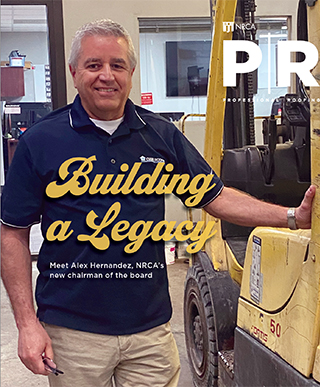NRCA elects new officers and directors
NRCA has elected its 2025-26 slate of officers and directors:
Alex Hernandez, president of Clark Roofing Co. Inc., Broadview, Ill., was elected chairman of the board, and Chad Collins, executive vice president of Roofing Corp of America, Atlanta, was elected chairman of the board-elect.
Jean-Paul Grivas, vice president of Ray Nolan Roofing, Louisville, Ky.; Paige Harvill, corporate projects manager for Nations Roof Gulf Coast, Mobile, Ala., and Diana Petersen, director of administration for Red Pointe Roofing LP, Orange, Calif., were elected vice chairmen for two-year terms. David Hesse, executive vice president of Kalkreuth Roofing and Sheet Metal Inc., Wheeling, W.Va.; Sherri Miles, president of Miles Roofing Inc., Chesapeake, Va.; and Tim Stephens, vice president of operations at Architectural Sheet Metal Inc., Orlando, Fla., were elected as vice chairmen for a one-year term.
Additionally, the following were elected as new NRCA directors:
- Tyler Allwood, director of business development for Eagle Roofing Products, Rialto, Calif.
- Rachna Bhatt, director of HRGM Corp., Washington, D.C.
- Tupac de la Cruz, founder of Roofing Solutions LLC, Baton Rouge, La.
- Collin DeBuysere, project manager for Roofing Technology Inc., Davenport, Iowa
- John Fleming, owner of Weathercraft Co. of Colorado Springs Inc., Colorado Springs, Colo.
- Tammara Hall, director of marketing and business development for CFS Roofing Services LLC, Fort Myers, Fla.
- Tina Hall, owner and CEO of Joe Hall Roofing & Contracting, Arlington, Texas
- Will Hamlin, president and CEO of The Hamlin Cos., Garner, N.C.
- Gary Howes, chief operating officer of The Durable Slate Co., Columbus, Ohio
- Allen Hughes, vice president of Rike Roofing Services, Fort Mill, S.C.
- Beth Kegley, director of national accounts for Beacon Building Products, Herndon, Va.
- Pierre Lafontaine, vice president of business services for Groupe Raymond, Quebec, Canada
- Paul Manchisi, senior vice president, Flynn Midwest, Flynn BEC, for Flynn Group of Companies, Toronto, Canada
- James Patterson, senior vice president of CentiMark Corp., Canonsburg, Pa.
- Kyle Price, service sales manager for Superior Services RSH Inc., Lansing, Mich.
- Rachel Reed, vice president of Tri-State/Service Roofing & Sheet Metal Group, Vienna, W.Va.
- Josh Steinrock, president of American Roofing & Metal Inc., Louisville, Ky.
Holcim appoints Amrize executive officers

Holcim has appointed the designated executive leadership team for Amrize.
The officers include:
- Jan Jenisch, chairman and CEO
- Ian Johnston, chief financial officer
- Jaime Hill, president of building materials
- Jake Gosa, president of building envelope
- Nollaig Forrest, chief marketing and corporate affairs officer
- Steve Clark, chief people officer
- Denise Singleton, chief legal officer and corporate secretary
- Sam Poletti, chief strategy and M&A officer
- Mario Gross, chief supply chain officer
- Roald Brouwer, chief technology officer
Study shows more worker benefits can lead to improved mental health
Construction workers die by suicide at a higher rate than the national average, according to the Centers for Disease Control and Prevention. But understanding the root causes as well as what can mitigate mental health struggles can help.
A webinar hosted by CPWR—The Center for Construction Research and Training sought to share information around those factors.
Jonathan Davis, assistant professor of occupational and environmental health at the University of Iowa, Iowa City, studied U.S. violent death data from 2013 through 2020. He found that of the nearly 130,000 people who died by suicide during that time, 15% of them worked in construction.
“Where we found the biggest difference for construction workers was alcohol and substance use,” Davis said during the webinar. “That lets us infer that any intervening on alcohol and substance use will likely bring down that rate of suicide.”
View Davis’ report about employment laws and construction worker suicide.
Davis also studied laws across states in an attempt to better understand what benefits correlate with improved mental health.
For example, states that have paid family medical leave had a 60% reduction in female suicides and a 21% reduction in male suicides compared with states that did not have such laws. Paid vacation time also correlated witha 7% reduction in male suicide and 32% in women, Davis said.
Those results provide “some suggestive evidence that paid leave would be something that would help bring down the rate of suicide especially if implemented at the employer-employee level,” he said.
A recording of the webinar is available at cpwr.com.
NRCA is committed to improving mental health awareness in the roofing industry. Its mental health resources are available at betoughenough.org.
What to know before selling your business

Roofing business owners put blood, sweat and tears into building their businesses. But at some point, it’s time for the next chapter of life to begin.
To maximize the value of your business in a sale, Peter Holton, managing director of Caber Hill Advisors, Chicago, shares what he calls the “5Ks.”
- Know what your business is worth. Typically, the largest asset owned by a business owner is his or her business. Many people ask: “How much is my business worth?” “At what multiple should I sell my business?” Each business is unique, and there is no simple formula or quick answer. The only way to know what your business is worth is to invest the resources into a comprehensive business valuation that will analyze your business internally and compare it to similar businesses that have recently been sold.
- Know what motivates buyers. There are three primary types of buyers: large companies, private equity groups and private individuals—and each has its own strategic objectives and a unique perception of value. It is vital to know how to present your business in a way that will align with a buyer’s motivation so you can negotiate a better deal.
- Know when to sell. If your business is thriving, you should sell now to maximize its value. When selling your business, you should consider personal timing, company timing and market timing. Although it seems natural to base your decision on personal timing—such as when you want to retire—personal timing is the least important factor. Buyers do not care you want to retire; they care whether your business is growing. And the market won’t be hot just because you want to sell; you can choose to sell when the market timing is right.
- Know the difference between price and terms. Although all business owners want to sell their companies for maximum value, too many owners only focus on the deal price without properly considering the deal terms, which can lead to disappointing results. Consider two offers for the same business:
- Offer A: $5 million paid all in cash at closing
- Offer B: $5.5 million paid out over 10 years
- Know how to manage the deal process. It is crucial to know and understand the steps in the deal process. Every deal is different, but on average, it can take roughly 6 to 12 months to sell a business. There are four keys to the deal process: preparation, marketing, deal structuring and closing. If the preparation is done correctly, all other portions of the deal process will flow smoothly.
Report addressing New York construction industry is released

The number of construction workers killed in New York state increased 48% in 2023 from 2022, translating to an 8.3% increase in the fatality rate, according to a recent report from a worker advocacy group.
The New York Committee for Occupational Safety and Health gathered data from multiple sources, including the New York State Department of Labor and the New York City Department of Buildings. It found 74 construction workers in the state died on the job in 2023—an increase from 50 in 2022. The worker fatality rate increased to 10.4 per 100,000 workers.
During that same time, the number of construction workers killed in New York City rose to 30 from 24, raising the worker fatality rate to 11.6 per 100,000 workers from 11.5.
The analysis also reveals 74% of the fatal incidents statewide had preventable safety violations, and 77% of the deaths were open-shop workers.
Latino workers comprise about 10% of New York state’s construction workforce, yet they accounted for 26% of the deaths in 2023.
NYCOSH also analyzed OSHA-inspected construction fatality cases and found in 73% of them, the employer had concurrent OSHA violations that often directly correlated with the circumstances of the death. For example, in cases in which workers died from falls, employers frequently were fined for failing to provide essential safety training and not implementing required fall-protection measures.
“We urgently need increased funding for enforcement and proactive measures to protect our most vulnerable workers,” says Charlene Obernauer, NYCOSH’s executive director. “These numbers represent a clear failure of our system to protect workers.”
The report features recommendations to address the rise in construction worker deaths:
- Require and fund adequate safety and training. This could include adopting regulations like New York City’s Construction Safety Training Law.
- Extend and defend protective legislation, such as the state’s Carlos’ Law, which increases penalties against employers responsible for worker injuries and deaths.
- Expand regulations, monitoring and enforcement. This can be achieved by prosecuting criminal contractors, suspending/revoking their licenses and funding more federal Occupational Safety and Health Administration safety programs.
- Increase funding for the NYC Department of Buildings.
- End public funding for contractors who are repeat offenders and tie subsidies to work protections.
- Address disparities in workplace deaths among Latino and immigrant workers.



